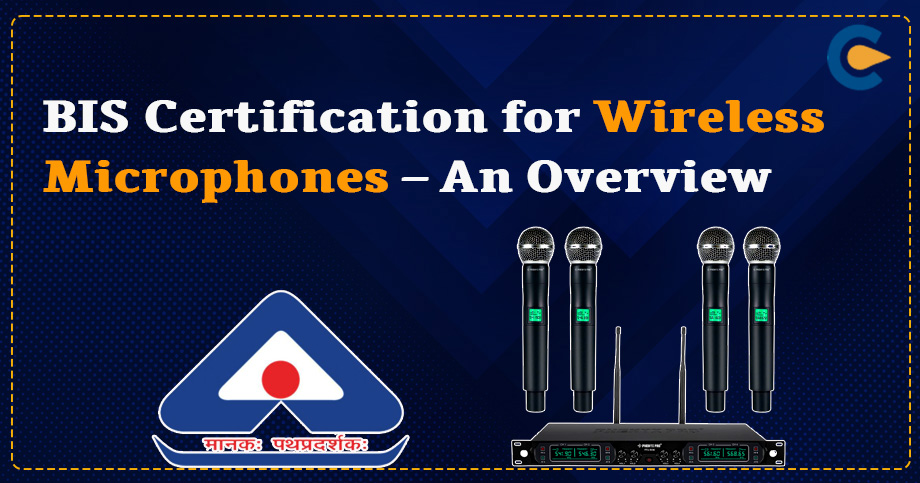The BIS Certification for Wireless Microphones is approved under Indian Standard IS 616:2017 for the safety requirements for audio, video, and similar electronic apparatuses. Before they are produced, sold, or imported into the Indian market, all models and brands of wireless microphones must obtain a BIS Certification under the BIS standards. Only manufacturers are given the BIS Certification for Wireless Microphones; any dealer, trader, or distributor is not allowed to get the same.
Technical Specifications of Wireless Microphone
A wireless microphone comprises of three parts- The Input Source, The Transmitter and The Receiver. The transmitter receives an audio signal from the input source. The transmitter transforms the audio signal into a radio signal before sending it out into the surrounding area. The receiver then receives the radio signal and converts it into an audio signal. The said components become a wireless microphone system after completing this entire process. Distribution systems and antennas are examples of additional system components. Some of the specifications of professional wireless microphones are as follows-
- Professional wireless microphones have separate mute and power switches to ensure that the receiver and transmitter are locked on the same frequency when talking to each other and that nothing can get into that system except for another system on the same frequency.
- Wireless microphones system have balanced outputs from the receiver to connect directly to the mixing console. Such connections cut down on or phase out noise and hum problems caused by the audio signal.
- Wireless microphones have rechargeable batteries that last 8-10 hours on one charge. Additional functions such as selectable High/Low signal strength may be added to help save the battery power for the portable wireless microphone system, and accessories like a quick charger would be accompanied to save your time in powering the device.
The process in which a wireless microphone operates is similar to that of radio communication. When purchasing a wireless microphone, keep the following five things in mind:
- Frequency
- Functional Range
- Reliability
- Audio Quality
- Features
What is BIS CRS?
The national standards body of India is the Bureau of Indian Standards or BIS. According to the BIS Act 2016[1], the Bureau of Indian Standards (Conformity Assessment) Regulation 2018 governs the Compulsory Registration Scheme (Scheme II of Schedule II). The Scheme aims to accelerate the development of the rapidly expanding electronic and information technology industries.
It has improved the domestic manufacturers’ ability to compete, given Indian consumers the right to high-quality products, and simultaneously protects them from fake and subpar goods. This strategy has allowed the Indian government to bridge the safety, technology, and human capital gaps and stop dumping non-compliant goods.
Obtaining a BIS certification is optional. However, the Central Government has mandated that several products adhere to Indian Standards. The compliance was implemented to safeguard the public interest, national security, the environment’s safety, and the health of people, animals, and plants.
The duties carried out by BIS are listed below-
- Creating and Publication Indian Standards
- Putting conformity assessment schemes into practice
- Appreciating the testing and research facilities
- Using hallmarking techniques
- Promoting consumer emancipation
- Offering consumers quality assurance
- Representing India at ISO and IEC
The central government has mandated that holders of a BIS license or certification of conformity must apply for permission before using standard marks (CoC).
The following certifications must be obtained by the products that are subject to mandatory certification:
- ISI mark scheme in Scheme-I
- CRS scheme in Scheme-II
- Issuing a certificate of conformity in Scheme IV
The Central Government listed seven new products to be included in the Schedule of the “Electronics and Information Technology Goods (Requirements for Compulsory Registration) Order, 2012” under the order issued by BIS on October 1, 2020, in S.O. 3429(E). The government’s mandatory certification program Scheme II covers the registration of BIS certification for Wireless microphones.
Tests to Check Quality Standards of Wireless Microphone
To conduct tests under the Compulsory registration scheme, or CRS, the Bureau of Indian Standards, or BIS, has established a format for uniform test reports that BIS-approved laboratories must follow.
The BIS certifies Wireless Microphones in accordance with Indian standards IS 616: 2017/ IEC 60065: 2014 by performing the laboratory tests listed below:
- Testing for marking requirements
- Radiation test
- Heat testing
- Test for electrical safety
- Test of mechanical properties
- Testing of the parts
- Wiring test
- Physical properties are tested
- Testing for splash-proofing effectiveness
- Test of communication connection
- Insulation properties testing
- Test for electrical safety
Basic Requirements to Obtain BIS Certification for Wireless Microphones
The following are some important requirements to obtain BIS Certification for Wireless Microphones:
- Product: If a manufacturer manufactures more than one product, the manufacturer has to file two separate BIS Certifications for each product category.
- Manufacturer: The BIS Certification is only issued to the manufacturer of the products. The importers, traders, or retailers do not apply for the BIS Certificate. However, they can act as an Authorised Representative of a manufacturer in India if the manufacturer doesn’t have an operating office in India. However, the BIS license is granted in the manufacturer’s name only.
- Manufacturing Address: The duly filled application form & required vital documents shall mention a proper manufacturing unit address. In case a manufacturer has more than one factory for manufacturing a product, then separate BIS Certification is required for each manufacturing unit.
- Brand or Trademark: A manufacturer producing the same product for different brands has to apply for separate BIS Certification.
Documents Required to Obtain BIS Certification for Wireless Microphones
Following are the documents required to obtain BIS Certification for Wireless Microphones:
- Completed CDF/CCL form
- Completed BIS application form
- The manufacturing facility’s business license
- Proof of Business License
- ISO certification of the manufacturer
- The product’s label or marking information
- Letter of authorisation (If the signatory person is other than the head of the manufacturing)
- Test Results
- Certification for Trademark
- Letter of Trademark Authorization (If TM is owned by other than the manufacturer)
- Registration proof of authorised Indian representative (in the case of the foreign manufacturer)
- Photo identification of the authorised Indian representative
- Product’s Technical Specification Sheet or User Guide
Procedure to Obtain BIS Certification for Wireless Microphones
The manufacturer must apply for the BIS certification to obtain BIS Certification for Wireless Microphones. For domestic (Indian) manufacturers, the BIS Registration procedure is different from that for a foreign manufacturer.
The process that a foreign manufacturer must follow is:
- The manufacturer must designate an AIR to carry out all of his obligations on his behalf.
- All required documentation must be submitted with the application.
- A BIS-approved laboratory must receive a product sample from the applicant for testing.
- The test results must be obtained by the manufacturer from the BIS-approved laboratory and submitted to the BIS office. If the reports are being submitted offline, a hard copy of the offline application form or a copy of the online application form must be submitted with the reports.
- The BIS office verifies and looks over the reports.
- The BIS office issues BIS Certification for Wireless Microphones to the manufacturer or authorised agent representative after verifying the information (AIR).
The process that an Indian manufacturer must follow is:
- The application must be submitted with all required supporting documentation.
- A BIS-approved laboratory must receive a product sample from the applicant for testing.
- The test results must be obtained by the manufacturer from the BIS-approved laboratory and submitted to the BIS office. If the reports are being submitted offline, a hard copy of the offline application form or a copy of the online application form must be submitted with the reports.
- The BIS office verifies and looks over the reports.
- The BIS office issues BIS Certification for Wireless Microphones to the manufacturer after verifying the information.
Conclusion
It is essential to obtain the BIS certification for wireless microphones under the compulsory registration scheme regulated by BIS. It ensures that the products received by the consumers are of good quality and free from any risk to health and human life. The BIS certification for wireless speakers ensures that consumers do not waste money on wrong or faulty products. It allows manufacturers to expand their business by increasing sales of quality-assured products and availing various benefits of BIS CRS. The application process to obtain BIS certification for a wireless microphone can be technical t understand, and the slightest error in the entire process may cause rejection of the application. Therefore, it is always suggested to take the help of professionals to obtain the BIS certification.
Read our Article:BIS Certification for Smart Speakers – An Overview













